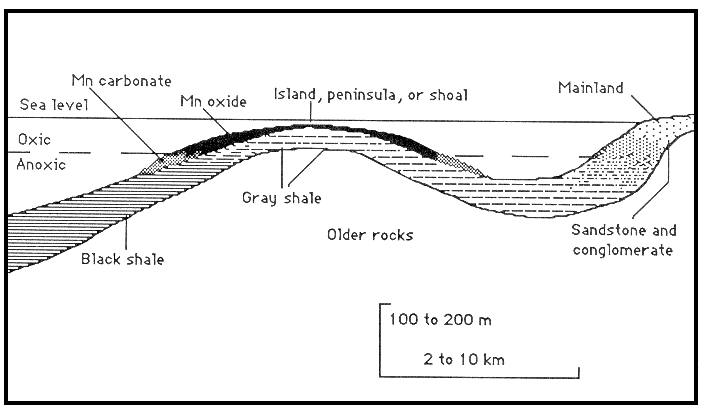
DESCRIPTIVE MODEL OF SEDIMENTARY Mn
MODEL 34b
By William F. Cannon and Eric R. Force
APPROXIMATE SYNONYM Bathtub-ring Mn.
DESCRIPTION Shallow marine (non-volcanogenic) sedimentary Mn deposits formed around rims of anoxic basins during transgression (see fig. 175).
Figure 175. Cartoon cross section showing relation of sedimentary facies to sedimentary Mn deposits.

GENERAL REFERENCE Cannon and Force (l983).
GEOLOGICAL ENVIRONMENT
Rock Types Shallow marine sediments, most commonly carbonates, clay, and glauconitic sand, commonly with shellbeds, in transgressive sequences associated with anoxic basins.
Age Range Mostly in "anoxic events," narrow time periods within the early Paleozoic, Jurassic, and mid-Cretaceous, but may be in rocks of any age associated with anoxic basins.
Depositional Environment Shallow (50-300 m) marine, commonly in sheltered sites around paleo-islands. Most deposits overlie oxidized substrates, but basinward, carbonate deposits may be in chemically reduced settings.
Tectonic Setting(s) Stable cratonic interior basin or margin.
Associated Deposit Types Locally, sedimentary phosporites, sediment-hosted Cu.
DEPOSIT DESCRIPTION
Mineralogy A variety of Mn carbonates (mostly basinward) and oxides (mostly landward).
Texture/Structure Commonly as oolites, pisolites, laminae, and shell replacements.
Alteration Supergene alteration to high-grade ore is common.
Ore Controls Oxidation-reduction interface (involves age, paleobasin reconstruction, paleodepth of site) and lack of clastic dilution.
Weathering Mn carbonates may weather to brown, nondescript rock. Black secondary oxides are common.
Geochemical Signature None known.
EXAMPLES
Molango (Jurassic), MXCO (Tavera and Alexandri, 1972)
Nikopol (Oligocene), USSR (Sapozhnikov, 1970)
Groote Eyland (Cretaceous), AUTN (Frakes and Bolton, 1984)